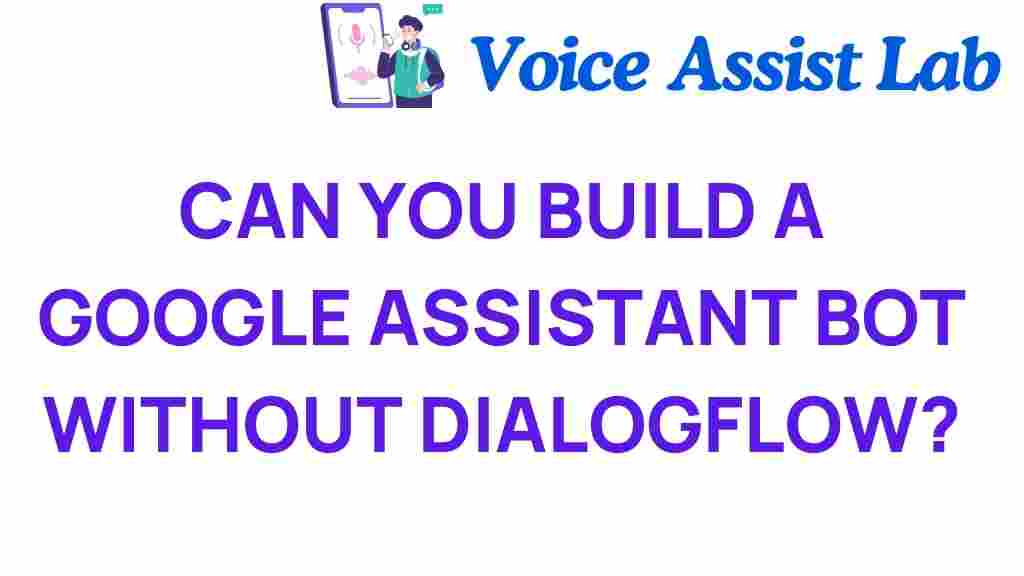Unlocking the Secrets: Building a Google Assistant Bot Without Dialogflow
In the ever-evolving landscape of voice technology, creating a Google Assistant bot can be a rewarding venture. With the rise of automation and AI tools, developers and enthusiasts alike are eager to explore the possibilities of building conversational agents. While Dialogflow is a popular choice for many, there are numerous Dialogflow alternatives that can help you craft a unique bot tailored to your needs. In this article, we’ll delve into the process of building a Google Assistant bot without relying on Dialogflow, empowering you with the knowledge to leverage your programming skills and enhance user interaction.
Understanding Google Assistant and Bot Development
The Google Assistant is an intelligent virtual assistant powered by AI technology, allowing users to engage in voice-activated interactions. Bot development for platforms like Google Assistant can enhance customer experiences, automate tasks, and provide quick access to information. Whether you are a seasoned developer or a hobbyist, learning how to create a bot can open up new avenues for innovation.
Why Consider Alternatives to Dialogflow?
While Dialogflow is a robust tool for natural language processing, it may not suit everyone’s needs. Here are a few reasons why you might explore Dialogflow alternatives:
- Cost Constraints: Some alternatives offer free tiers that can be more budget-friendly.
- Customization: Alternatives may provide greater flexibility in coding and functionality.
- Data Control: Certain platforms allow you to maintain better control over your data.
- Specific Use Cases: Depending on your project, some alternatives may cater better to niche requirements.
Step-by-Step Process to Build a Google Assistant Bot
Here’s a comprehensive guide to building your own Google Assistant bot without Dialogflow. This guide will utilize basic programming skills and various AI tools to help you achieve your goal.
Step 1: Set Up Your Development Environment
Before diving into development, you need to establish your programming environment. Here’s how to get started:
- Install Node.js: This will be the backbone of your bot. Download it from the official Node.js website.
- Code Editor: Choose a code editor like Visual Studio Code or Sublime Text for writing your bot code.
- Google Cloud Project: Create a project on the Google Cloud Platform to manage your bot’s API and services.
Step 2: Create Your Bot Logic
Now that your environment is set up, it’s time to create the core logic of your bot. You’ll need to write JavaScript code that defines how your bot responds to user requests.
This involves:
- Defining Intents: Determine what the user might ask and how your bot should respond.
- Writing Functions: Implement functions that handle user input and generate appropriate responses.
- Maintaining State: Consider using session management to keep track of user interactions.
Step 3: Integrate Voice Technology
To enable voice interaction, you’ll need to utilize the Google Assistant SDK. Here’s how:
- Install the SDK: Use npm to install the Google Assistant SDK.
- Authenticate: Set up OAuth 2.0 credentials in your Google Cloud project to allow your bot to communicate with Google Assistant.
- Write Integration Code: Code the interaction layer that connects your bot logic with the Google Assistant SDK.
Step 4: Test Your Bot
Before deploying your bot, thorough testing is crucial. Here’s how to ensure everything works smoothly:
- Use the Simulator: Google provides a simulator to test your bot’s responses without needing physical devices.
- Debugging: Check for errors in your code and ensure that intents are recognized correctly.
- User Feedback: If possible, let other users interact with your bot to gather feedback for improvements.
Step 5: Deployment
Once you’re satisfied with your bot’s performance, it’s time to deploy it:
- Hosting: Choose a hosting platform like Heroku or AWS to run your bot.
- Publish: Follow Google’s guidelines to publish your bot on the Google Assistant platform.
Step 6: Monitor and Improve
Post-deployment, you should continuously monitor your bot’s performance:
- Analytics: Utilize Google Cloud’s analytics tools to track user interactions.
- User Interaction Data: Gather insights from user interactions to refine and enhance your bot’s capabilities.
- Iterate: Regularly update your bot based on feedback and technological advancements.
Troubleshooting Common Issues
Even with careful planning, you may encounter issues during development. Here are some common problems and their solutions:
Error: Bot Not Responding
Solution: Check your integration with the Google Assistant SDK and ensure your intents are set up correctly. Utilize console logs to debug your code.
Error: Authentication Issues
Solution: Verify your OAuth 2.0 credentials in the Google Cloud Platform and ensure that your bot has the necessary permissions.
Performance Issues
Solution: Optimize your code for performance and consider using caching mechanisms for frequently accessed data.
Conclusion
Building a Google Assistant bot without Dialogflow is not just possible, but it can also be an enriching experience that enhances your programming skills. By following the steps outlined in this article, you can create a bot that meets your specific needs while leveraging the power of voice technology and automation.
Whether you’re looking to create a simple assistant or a complex interaction platform, the tools and methods discussed here will set you on the right path. As you embark on your bot development journey, don’t hesitate to explore various AI tools and frameworks that can elevate your project further.
For more information on voice technology and bot development, check out this comprehensive guide on the subject. Happy coding!
This article is in the category Voice and created by VoiceAssistLab Team

1 thought on “Unlocking the Secrets: Building a Google Assistant Bot Without Dialogflow”